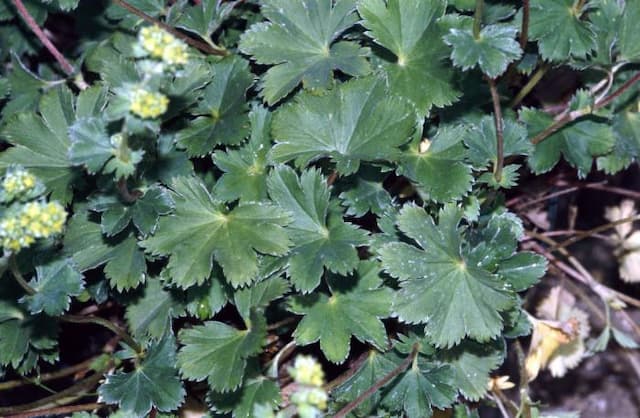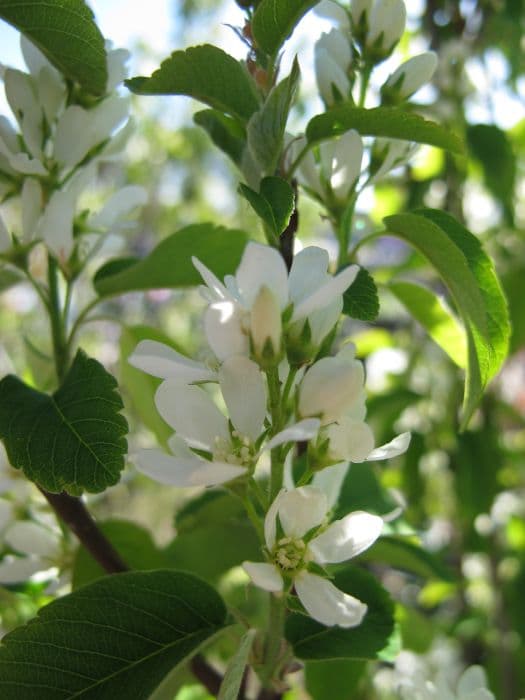Czar Plum Prunus domestica 'Czar' (C)

ABOUT
The plum tree known as 'Czar' is a deciduous fruit tree that is recognized for its aesthetic appeal and productivity. It features a rounded canopy with branches that spread out gracefully. The leaves of the 'Czar' are relatively broad and have a rich green hue with a slightly glossy appearance, which provides a lush backdrop for the blossoms and fruit. During the spring, this plum tree is adorned with delicate white flowers that offer a picturesque display and are attractive to pollinators such as bees. Following the flowering period, the tree produces fruit that is typically oval in shape. The skin of the plums is deep purple, almost bordering on black, with a light powdery bloom that gives the fruit a matte finish. Upon ripening, these plums reveal juicy, yellow-green flesh on the inside that is both sweet and slightly tart, making them a popular choice for fresh eating as well as for culinary uses such as jams and preserves. The 'Czar' plum variety is often praised for its rich taste and the relatively early harvest season it offers.
About this plant
 Names
NamesFamily
Rosaceae
Synonyms
Czar Plum
Common names
Prunus domestica 'Czar'
 Characteristics
CharacteristicsLife cycle
Perennials
Foliage type
Deciduous
Color of leaves
Green
Flower color
White
Height
12-15 feet (3.6-4.6 meters)
Spread
10-12 feet (3-3.7 meters)
Plant type
Tree
Hardiness zones
5
Native area
Europe
Benefits
 General Benefits
General Benefits- Decorative Fruit: Produces attractive purple-blue fruits that can enhance the visual appeal of a garden or landscape.
- Edible Produce: The plums are not only beautiful but also edible, providing a source of fresh fruit for consumption.
- Shade Provider: The moderately large size of the plum tree offers shade in gardens and outdoor living spaces.
- Wildlife Attraction: The flowers provide nectar for pollinators like bees, while the fruit can attract birds and other wildlife.
- Seasonal Interest: Offers a variety of visual interest with its white spring blossoms and colorful fruit in late summer.
- Compact Growth: Suitable for smaller gardens due to its relatively compact growth habit compared to other fruit trees.
 Medical Properties
Medical Properties- Constipation Relief: The European plum, which is the fruit of Prunus domestica 'Czar', is often used for its laxative effects due to the high fiber content found in the fruit.
- Antioxidant Properties: European plums contain antioxidants, such as vitamins A and C, which are important for neutralizing harmful free radicals in the body.
- Blood Sugar Regulation: The fiber in plums can help in managing blood sugar levels by slowing down the rate at which food leaves the stomach and by improving insulin sensitivity.
- Digestive Health: The dietary fiber in plums can contribute to the overall health of the digestive system, aiding in the prevention of digestive disorders like diverticulitis.
 Air-purifying Qualities
Air-purifying QualitiesThis plant is not specifically known for air purifying qualities.
 Other Uses
Other Uses- The wood of the plum tree can be used for smoking meats and cheeses, offering a mildly sweet smoke flavor.
- Plum leaves can be steeped to make a natural dye for fabrics, yielding various shades of green depending on the mordant used.
- The plum tree's blossoms can be used in floral arrangements or potpourri for their aesthetic appeal and gentle fragrance.
- In some cultures, plum branches are used as a traditional decoration during certain festivals or celebrations to symbolize luck and prosperity.
- Small, unripe plums can be pickled to create a tart condiment or snack, commonly enjoyed in Middle Eastern cuisines.
- Mature plum wood is hard and finely grained, making it suitable for crafting small wooden objects like handles, knobs, and toys.
- Fallen plum leaves and pruned branches can be added to a compost pile as a source of carbon, enriching the resulting soil amendment.
- Plum stones or pits, once cleaned, can be used as a natural abrasive for cleaning or as porous stones in drainage layers for potted plants.
- The dense foliage of the plum tree can provide shelter and habitat for birds and beneficial insects within a garden ecosystem.
- The tree can be incorporated into educational activities or programs, teaching children about plant growth, fruit development, and the life cycle of trees.
Interesting Facts
 Feng Shui
Feng ShuiThe plum tree is not used in Feng Shui practice.
 Zodiac Sign Compitability
Zodiac Sign CompitabilityThe plum tree is not used in astrology practice.
 Plant Symbolism
Plant Symbolism- Regeneration and Renewal: The Czar plum tree is a deciduous tree that sheds its leaves in autumn and grows new ones in spring, symbolizing the ideas of rebirth and starting anew.
- Abundance and Wealth: Plum trees are often abundant in their fruit production, and the Czar plum, with its generous crop, can represent material wealth or the richness of the harvest.
- Inner Richness and Spiritual Wealth: Plums can also symbolize internal abundance, such as the wealth of knowledge, wisdom, and spiritual well-being.
- Persistence and Endurance: As a hardy fruit tree variety, the Czar plum represents endurance through harsh conditions, and the ability to persist through difficulties.
- Innocence and Purity: The delicate white flowers of the plum tree can signify purity and the innocence of youth or beginnings.
- Beauty and Elegance: With its graceful form and beautiful flowers, the plum tree is often associated with aesthetic beauty and elegance.
 Water
WaterFor the Czar Plum tree, it is important to ensure consistent moisture, especially during the growing season. Initially, water young trees thoroughly once a week with about 2 to 3 gallons per watering session, to establish a strong root system. Mature trees can be watered less frequently; however, during extended dry spells, it is crucial to provide supplemental watering, potentially increasing to 2 to 4 times a month, depending on soil type and weather. Overwatering can be as detrimental as under-watering, so let the soil dry out slightly between watering sessions. It is best to provide a deep watering to encourage deep root growth rather than frequent shallow waterings.
 Light
LightCzar Plum trees thrive best in full sun conditions, which means they require at least six hours of direct sunlight each day. Planting the tree in a spot where it can receive unfiltered sunlight throughout the day will promote healthy growth and an abundant fruit yield. Avoid areas that are shaded for prolonged periods as this can reduce fruiting and make the tree susceptible to diseases.
 Temperature
TemperatureCzar Plum trees are hardy and can tolerate a range of temperatures; however, they grow best when the temperature is between 65°F and 75°F. They are capable of withstanding winter cold down to -20°F and summer heat up to 95°F, making them suitable for many temperate regions. Frosts below this range can damage blossoms and affect fruit production, so it is important to plant them in locations that avoid late spring frosts.
 Pruning
PruningPruning Czar Plum trees is essential to remove dead or diseased wood, to shape the tree for better sunlight penetration and air circulation, and to encourage the growth of fruit-bearing branches. The best time for pruning is in late winter or early spring before new growth starts. Prune annually to maintain the health and productivity of the tree, focusing on thinning out crowded branches and cutting back those that cross or rub against each other.
 Cleaning
CleaningAs needed
 Soil
SoilThe Czar plum prefers a well-drained, fertile soil mix with a pH between 5.5 and 6.5. A combination of loam, organic compost, and some sand or perlite to improve drainage constitutes the best soil mix for this fruit tree.
 Repotting
RepottingCzar plums planted in containers may need repotting every couple of years, but mature trees planted outdoors do not require repotting. Evaluate root growth in spring to decide if repotting is necessary.
 Humidity & Misting
Humidity & MistingCzar plums do well in average outdoor humidity levels; they do not have specific humidity requirements as they are adapted to a range of outdoor conditions.
 Suitable locations
Suitable locationsIndoor
Not suitable for indoor growth due to size.
Outdoor
Plant in full sun, well-drained soil, and prune annually.
Hardiness zone
5-9 USDA
 Life cycle
Life cycleThe life of the Czar plum (Prunus domestica 'Czar') begins with a seed germination process which typically occurs in the spring following stratification. After germination, the seedling goes through a juvenile phase where it grows vegetatively, establishing a root system and young shoots. As the tree matures, it enters the adult vegetative stage, developing a sturdy trunk, branches, and foliage; this stage may last several years before it reaches reproductive maturity. The reproductive phase starts when the tree begins to blossom annually, usually in late winter to early spring, with showy white flowers that are attractive to pollinators. Following pollination, the flowers develop into plums during the summer, which ripen to be harvested late in summer to early autumn. The tree continues to cycle through vegetative growth and fruiting in subsequent years, potentially living and producing fruit for several decades before reaching the end of its life cycle.
 Propogation
PropogationPropogation time
Summer-early autumn
The Prunus domestica 'Czar', commonly known as the Czar plum, is typically propagated by grafting, which is the most popular propagation method for this plant. The best time for grafting is in late winter to early spring, just before the growing season begins. In this process, a healthy scion (a young shoot or twig) from the Czar plum is joined to a compatible rootstock, which may be of a different, but related, plum species or variety that is known for good root characteristics. The scion and rootstock are cut at compatible angles to maximize contact between the vascular cambium of each, then they're bound tightly together with grafting tape or wax to hold the joint in place and prevent drying out. This union needs to be kept under the right environmental conditions until the graft has taken, which usually means ensuring the newly grafted plant is kept at a constant temperature of around 70-75 degrees Fahrenheit (around 21-24 degrees Celsius) and high humidity.









